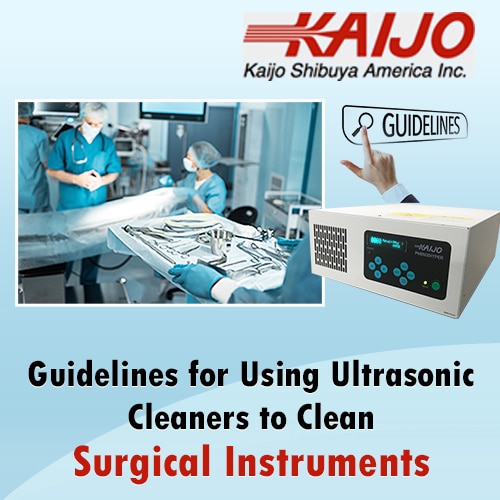Guidelines for Using Ultrasonic Cleaners to Clean Surgical Instruments
June 22, 2021
 When surgical tools and instruments are difficult to clean and sterilize with traditional methods, ultrasonic cleaners can deliver excellent cleaning and sterilizing performance. Some instruments, such as laparoscopes used in minimally invasive surgery, may have heat-sensitive components and can’t be sterilized in an autoclave. Instruments may have complex shapes with areas impossible to reach with manual cleaning. Using ultrasonic cleaners also reduces the risk to medical personnel of handling sharp tools.
When surgical tools and instruments are difficult to clean and sterilize with traditional methods, ultrasonic cleaners can deliver excellent cleaning and sterilizing performance. Some instruments, such as laparoscopes used in minimally invasive surgery, may have heat-sensitive components and can’t be sterilized in an autoclave. Instruments may have complex shapes with areas impossible to reach with manual cleaning. Using ultrasonic cleaners also reduces the risk to medical personnel of handling sharp tools.
As a result, the use of ultrasonic cleaners in medical facilities is growing. Ultrasonic technology cleans quickly and completely. While the ultrasonic cleaning process does not itself sterilize, adding a suitable amount of disinfectant to the cleaning solution results in sterile instruments.
Typical Guidelines for Medical Use of Ultrasonic Cleaners
While ultrasonic cleaners are effective for cleaning and sterilizing surgical instruments, cleaners have to be set up for the specific cleaning application. In addition to following the surgical instrument manufacturer’s instructions for use (IFU), the size, frequency, temperature and bath solution have to match the cleaning application. An experienced ultrasonic cleaner manufacturer can help select a suitable ultrasonic cleaner for medical instruments and configure it to perform as required. The following guidelines can help ensure safe and effective operation.
- Although the ultrasonic cleaner is highly effective for cleaning and sterilizing, normal medical procedures should always be followed. For example, instruments should be rinsed right after use or kept moist to prevent blood and other material from drying out. Dried contamination is harder to remove and cleaning may take a lot longer.
- The manufacturer’s recommendations and the IFU should always be followed. Some manufacturers are now recommending the use of ultrasonic cleaners. In that case, medical personnel should work with the ultrasonic cleaner supplier to make sure the instrument manufacturer’s requirements are fulfilled.
- Effective cleaning depends on using the correct ultrasonic frequency. Cleaners used with only one type of instrument or application may have a fixed frequency. General purpose cleaners can typically be operated at several frequencies, depending on what is being cleaned. The use of the correct frequency should be checked.
- Sterilization depends on using the right disinfectant and the right quantity. The IFU sometimes specify disinfectants to be used and applicable research may be available for specific cases. Medical personnel should verify the type and concentration of the cleaning solution.
- When operating properly, medical ultrasonic cleaners deliver stainless steel instruments that are shiny and completely clean while other parts will be visibly free of contaminants. A visual inspection after cleaning can confirm that the ultrasonic cleaner is working as expected and that all contaminants have been removed from the surgical instruments.
- In addition to general instructions for the use of ultrasonic cleaners, medical facilities should prepare specific use-based policies and procedures for cleaning different types of instruments with ultrasonic technology. A manufacturer of ultrasonic cleaners for surgical instruments can help with the preparation of such procedures and ensure that the right unit is being used in each case.
Ultrasonic cleaners are an important addition to medical facility equipment and they can improve patient outcomes, increase efficiency and reduce manual cleaning tasks. To achieve these results, the ultrasonic cleaners have to be configured for the particular cleaning application and used according to the correct procedures.
Kaijo works closely with customers to make sure their ultrasonic cleaning equipment meets their needs. Company involvement in ultrasonic technology dates back to 1948 and their first ultrasonic cleaner was released in 1957. Based on this extensive experience in ultrasonic cleaning systems, Kaijo offers a complete line of ultrasonic cleaners and equipment. Because the company designs and builds its equipment in house, ultrasonic cleaners can be customized to meet cleaning application requirements. Kaijo is an ideal partner for delivering medical ultrasonic cleaners for specific surgical instrument cleaning tasks.





